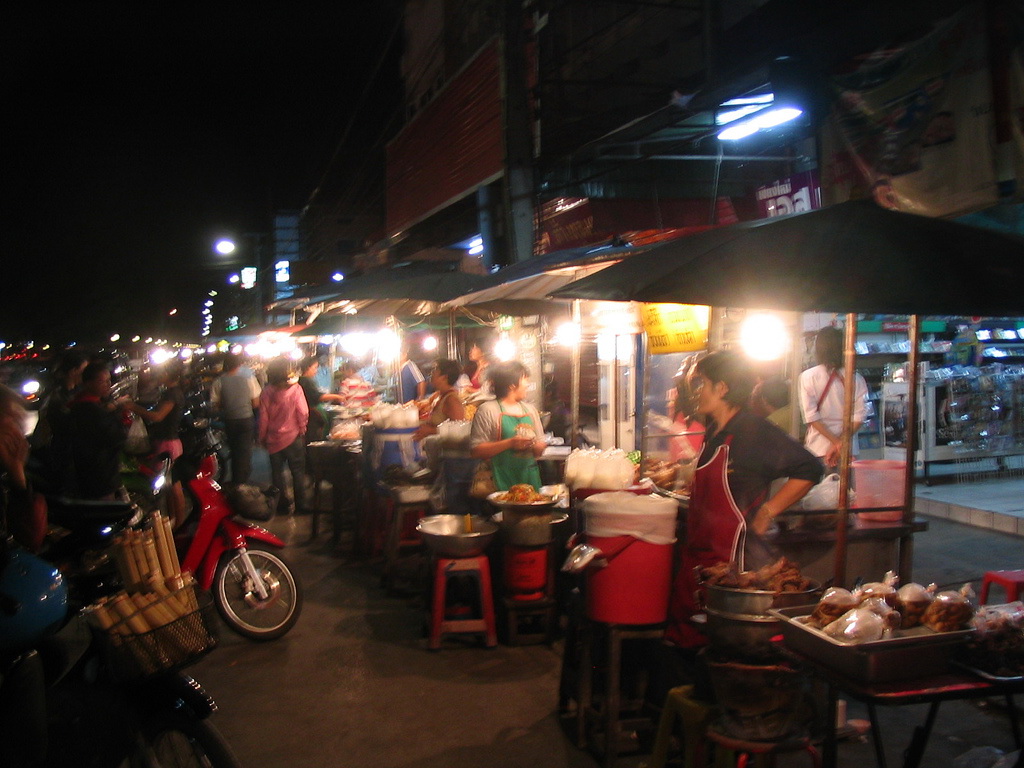After a long day (or night) in bustling Chiang Mai, nothing beats a dish of rich, aromatic noodles. The number of noodle based dishes in Chiang Mai (and Thailand in general) are plentiful and with recipes ranging from heavy, spicy dishes to light, soups you can bet you’ll find something to please everyone. Whether you opt to eat in a local restaurant or from a street vendor in one of the city’s food markets, authentic Thai noodles can the perfect end to a heavy night out. Here are seven of the top midnight noodles in Chiang Mai and where you can find them.

Photo by Chris Greb.
‘Drunken Noodles’ (Phad kee mao)
This spicy noodle dish is popular amongst late night revellers and not just because they are drunken too. Traditionally made up of broad rice noodles, beef and vegetables, this dish can be served with or without a spicy/sour broth but in either case it packs a punch with the spice factor thanks to the healthy dose of chili and black pepper within. This is where it gets its name from as people often struggle to stomach the heat of this dish without drinking a lot. One great place to pick up a fabulous version of this dish is North Gate Night Market in Old City Chiang Mai thought to be one of the best food markets in the world.
Mi krop
The literal translation of mi krop is ‘crisp noodles’ and that is exactly what you get with this dish. The thin rice noodles are fried to a perfect level of crispiness than served underneath a sweet, sticky sauce with citrus flavours. They are often then served alongside shrimp, pork or chicken.
Khao soy
This noodle dish has become synonymous with Chiang Mai and is a true taste of the region. More of a noodle soup, this dish includes wheat or egg based noodles in a light curry broth and is often accompanied by sides of green pickled salad and lime. Being such a staple part of Chiang Mai’s heritage, you can pick this tasty little dish up pretty much anywhere but restaurants that specialize in it include Khao Soi Prince and Khao Soi Kun Yai which are both in the Mueang district. Often full of locals (always a sign of a good restaurant) each of these restaurants have been hailed as ‘hidden gems’ that excel in this popular dish.
Pad see-ew
This dish uses slightly different noodles which are broad and flat rather than long and thin. They are known as rivier noodles and are thought to be healthier than rice noodles as they provide longer lasting bursts of energy. It is traditionally a Chinese dish but has become very popular in Thai cuisine too. Often served with thinly sliced meat such as beef, chicken and pork the staple ingredients of this dish include dark soy sauce, garlic and broccoli.
Kanomjeen nam ngiao
Tradtional cuisine of the Tai Yai people of Burma, China and Northern Thailand. A characteristically tangy dish, nam ngiao is predominantly made from fermented rice vermicelli and is brought to life with tomatoes and dried chilli flakes for that added flavor. Beef, pork or curdled blood cake are usually added and the dish along with a type of fermented soy bean.
Pad Thai
A famous dish served throughout Thailand, Pad Thai is perhaps one of the most popular noodle dishes in Asia. The rice noodles are stir fried with egg and tofu then typically served with fish sauce, shallots, chilli and sugar, often accompanied by lime and chopped peanuts. Any trip to Thailand would not be complete without sampling Pad Thai at least once, but with many variations of the dish you may find yourself wanting more. People often say that the most authentic Pad Thai can be picked up from street vendors who have years of experience in cooking and experimenting with the dish (which can often be served in banana leaves instead of plates).
Kuay tiew rua
Kuay tiew ruaor ‘boat noodles’ is a noodle dish with intense flavours containing ingredients that aren’t for the faint hearted. Made up from noodles, meat, dark soy sauce, spices and bean curd this dish is usually served alongside pig’s liver and can contain seasoned cow or pig’s blood too. The dish’s name comes from its beginnings as a soup served in small bowls from the boats that traveled up the Bangkok canals and even now the best places to find it usually include riverside restaurants.